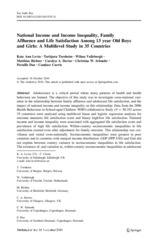National Income and Income Inequality, Family Affluence and Life Satisfaction Among 13 year Old Boys and Girls: A Multilevel Study in 35 Countries
Levin, Kate Ann; Torsheim, Torbjørn; Vollebergh, Wilma; Richter, Matthias; Davies, Carolyn A.; Schnohr, Christina W.; Due, Pernille; Currie, Candace
Peer reviewed, Journal article
Published version
Permanent lenke
https://hdl.handle.net/1956/4546Utgivelsesdato
2010Metadata
Vis full innførselSamlinger
Originalversjon
https://doi.org/10.1007/s11205-010-9747-8Sammendrag
Adolescence is a critical period where many patterns of health and health behaviour are formed. The objective of this study was to investigate cross-national variation in the relationship between family affluence and adolescent life satisfaction, and the impact of national income and income inequality on this relationship. Data from the 2006 Health Behaviour in School-aged Children: WHO collaborative Study (N = 58,352 across 35 countries) were analysed using multilevel linear and logistic regression analyses for outcome measures life satisfaction score and binary high/low life satisfaction. National income and income inequality were associated with aggregated life satisfaction score and prevalence of high life satisfaction. Within-country socioeconomic inequalities in life satisfaction existed even after adjustment for family structure. This relationship was curvilinear and varied cross-nationally. Socioeconomic inequalities were greatest in poor countries and in countries with unequal income distribution. GDP (PPP US$) and Gini did not explain between country variance in socioeconomic inequalities in life satisfaction. The existence of, and variation in, within-country socioeconomic inequalities in adolescent life satisfaction highlights the importance of identifying and addressing mediating factors during this life stage.
Utgiver
SpringerOpphavsrett
Copyright The Author(s) 2010. This article is published with open access at Springerlink.comThe Author(s) 2010

